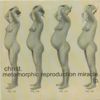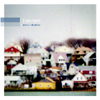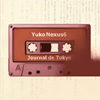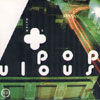 Christ's first full-length album is a dubby and thick pudding of scarydreams and rainbow-filled landscapes. Christ has been compared toBoards of Canada before, but I think it would be a mistake to leave adescription of Metamorphic Reproduction Miracleat that. The songs walk a fine line between static repetition andirregular activity. Keyboards will chime and gurgle while a solidrhythm runs around in circles in the background; they are inseperablefrom eachother and the effect of one relies on the effect of the other.As a result the music often feels like a blob slowly oozing its way upmy body. There are plenty of detuned tones and happy melodies, butthere is an added element (mostly in the early tracks) of horror, too."Lazy Daisy Meadow" features a sizzling electronic voice sufferingunder an overcast of humming clouds and "Dianoes Nouveau" is abrilliant dub-influenced piece armed to the teeth with anxiety,apprehension, and a stunning arrangement that coheres into a mass ofbeautiful melody. The manner in which Christ arranges his instrumentsis confusing at first. The music has movement and there's an element ofhip-hop in some songs, but often there's a feeling as if the music isonly producing the illusion of movement. The quality of the entirealbum is very organic and gooey. Metamorphic is neitherentirely dark nor wholly joyous; instead it strikes a nice balancebetween the two extremes that makes it listenable at about any time.I'd like to hear more from Christ, especially something focused on thesound exposed in "Dianoes Nouveau." Eventually the goo dries up and bythe time "School Is Not Compulsory" fades away I'm left feeling alittle teased. The same thing that makes the early part of this albumgreat ends up making the last part feel a bit drawn out: a little morevariation and breath outside the blob would certainly be nice.
Christ's first full-length album is a dubby and thick pudding of scarydreams and rainbow-filled landscapes. Christ has been compared toBoards of Canada before, but I think it would be a mistake to leave adescription of Metamorphic Reproduction Miracleat that. The songs walk a fine line between static repetition andirregular activity. Keyboards will chime and gurgle while a solidrhythm runs around in circles in the background; they are inseperablefrom eachother and the effect of one relies on the effect of the other.As a result the music often feels like a blob slowly oozing its way upmy body. There are plenty of detuned tones and happy melodies, butthere is an added element (mostly in the early tracks) of horror, too."Lazy Daisy Meadow" features a sizzling electronic voice sufferingunder an overcast of humming clouds and "Dianoes Nouveau" is abrilliant dub-influenced piece armed to the teeth with anxiety,apprehension, and a stunning arrangement that coheres into a mass ofbeautiful melody. The manner in which Christ arranges his instrumentsis confusing at first. The music has movement and there's an element ofhip-hop in some songs, but often there's a feeling as if the music isonly producing the illusion of movement. The quality of the entirealbum is very organic and gooey. Metamorphic is neitherentirely dark nor wholly joyous; instead it strikes a nice balancebetween the two extremes that makes it listenable at about any time.I'd like to hear more from Christ, especially something focused on thesound exposed in "Dianoes Nouveau." Eventually the goo dries up and bythe time "School Is Not Compulsory" fades away I'm left feeling alittle teased. The same thing that makes the early part of this albumgreat ends up making the last part feel a bit drawn out: a little morevariation and breath outside the blob would certainly be nice.
Two new shows just for you. We have squeezed out two extended release episodes for this weekend to get you through this week. They contain mostly new songs but there's also new issues from the vaults. The first show features music from Rider/Horse, Mint Field, Robert Aiki Aubrey Lowe, Anastasia Coope, ISAN, Stone Music, La Securite, Bark Psychosis, Jon Rose, Master Wilburn Burchette, Umberto, Wand, Tim Koh, Sun An, and Memory Drawings. The second episode has music by Laibach, Melt-Banana, Chuck Johnson, X, K. Yoshimatsu, Dorothy Carter, Pavel Milyakov, Violence Gratuite, Mark Templeton, Dummy, Endon, body / negative, Midwife, Alberto Boccardi, Divine. Cow in Maui from Veronika in Vienna. Get involved: subscribe, review, rate, share with your friends, send images! |



 Then there's that scene in the Wizard of Oz where the hurricane comesknocking on the door and there's no stopping it. Sightings latest albumopens with the sound of the scenes that would have been cut from thefilm for being too graphically violent. There's a mess of nature at thedoor and it's ready to explode itself on everybody inside, blasting allwith a violent barrage of dirt, water, debris and a tractor orsomething. It's impossible to shut the door, it's impossible to escape,and nothing is safe in its path. There's only a few points where theattack becomes less violent, like by the third track, "Anna Mae Wang,"which, at its calmest, sounds like a busy construction site. But, theparty starts back up again with the closest Sightings will ever come toa funky post-punk dancefloor smash, "Bishops," and continues with theequally dancey "Canadian Money." The second half is certainly a morebody friendly as songs like "Right Side of the Hall" could be an homageto the violent techno of earlier Panacea days while the closer,"Reduction" could pass for Liquid Liquid or A Certain Ratio put througha distorted Sightings-designed noise filter. Make no mistake about it:there's nothing accidental about their sound, as the trio full aware ofthe potential of gear and the ability to make everything moreblistering and sweaty without making it sound like a crackpot crew ofamateurs. It makes me proud to live in such a wonderful time whenrockers and noisemongers can live in ear bleeding disharmony.
Then there's that scene in the Wizard of Oz where the hurricane comesknocking on the door and there's no stopping it. Sightings latest albumopens with the sound of the scenes that would have been cut from thefilm for being too graphically violent. There's a mess of nature at thedoor and it's ready to explode itself on everybody inside, blasting allwith a violent barrage of dirt, water, debris and a tractor orsomething. It's impossible to shut the door, it's impossible to escape,and nothing is safe in its path. There's only a few points where theattack becomes less violent, like by the third track, "Anna Mae Wang,"which, at its calmest, sounds like a busy construction site. But, theparty starts back up again with the closest Sightings will ever come toa funky post-punk dancefloor smash, "Bishops," and continues with theequally dancey "Canadian Money." The second half is certainly a morebody friendly as songs like "Right Side of the Hall" could be an homageto the violent techno of earlier Panacea days while the closer,"Reduction" could pass for Liquid Liquid or A Certain Ratio put througha distorted Sightings-designed noise filter. Make no mistake about it:there's nothing accidental about their sound, as the trio full aware ofthe potential of gear and the ability to make everything moreblistering and sweaty without making it sound like a crackpot crew ofamateurs. It makes me proud to live in such a wonderful time whenrockers and noisemongers can live in ear bleeding disharmony. Often, what is said only complicates matters, and what can be seen orshown carries more weight, especially when it is expressed in athoughtful way. Minor Shadowsplays like the accompaniment to a film or documentary, but instead ofthe music enhancing images and ideas that it is purposefully coupledwith, here they conjure those images themselves. Their long pieces arecomposed and arranged as if with a cinematographer's eye; each note orpluck positioned to lend the scene the proper depth, the most vividillumination or the right shading to reveal the finest details thatgives the image, whether visual or aural, the greatest sensual impact.The patient, lingering guitar strokes of "In 1983 He Loved to Fly"seize upon implications of the title's past tense verb. It creates afeeling of watching someone living out a memory, staring at a gray skyas the warmth of the guitar plucks hovers while the accompaniment fadesaway leaving it alone and precariously aloft, unsupported. The chordstroke fades, only to return just as intensely before repeating itsreminder again and again. 1 Mile North finds that subtlety andrestraint can be virtues and employs them throughout Minor Shadows,never lapsing into indulgent tedium, but finding a comfortable nook inwhich to base their songs before they move outward. Their progressionis not explosive, nor is it fiery. The tension and presence is feltlike heat from a radiator, filling the room in waves. "The Sick" beginswith a simple strum, different from the preceding songs in that it issomewhat more ragged, more percussive in its strike. Sampled drums hitscrop up intermittently as keyboards rise and fall around giving aneerie mood to the piece. Finally, the strum unfurls into a melody thatreleases the anxiety it initially presented, not by speeding up orsnarling out but simply elaborating on the plot. In this sense, asingle hushed word is worth a thousand shouted ones. This dichotomyappears almost literally on the next track, "Black Lines," whichfeatures a film sound clip of a father viciously berating and verballyabusing his son. In response, 1 Mile North plays along with theirpatient track as if assuming the point of view of the victim of theclip. Their music finds both the fear of the situation but in itssteady keyboard melody it also implies an almost triumphant resolve.The clip adds a wonderful tension to the track, and provides anexcellent foil for 1 Mile North to converse with. This dialog serves asan argument, the fury of the actor mingling with the music, and yet forall the histrionics he flings, he is unable to unsettle it. It is amoment of insight where Minor Shadows proves that quite a bit can be said or shown when care and consideration is taken to crafting an intricate scene.
Often, what is said only complicates matters, and what can be seen orshown carries more weight, especially when it is expressed in athoughtful way. Minor Shadowsplays like the accompaniment to a film or documentary, but instead ofthe music enhancing images and ideas that it is purposefully coupledwith, here they conjure those images themselves. Their long pieces arecomposed and arranged as if with a cinematographer's eye; each note orpluck positioned to lend the scene the proper depth, the most vividillumination or the right shading to reveal the finest details thatgives the image, whether visual or aural, the greatest sensual impact.The patient, lingering guitar strokes of "In 1983 He Loved to Fly"seize upon implications of the title's past tense verb. It creates afeeling of watching someone living out a memory, staring at a gray skyas the warmth of the guitar plucks hovers while the accompaniment fadesaway leaving it alone and precariously aloft, unsupported. The chordstroke fades, only to return just as intensely before repeating itsreminder again and again. 1 Mile North finds that subtlety andrestraint can be virtues and employs them throughout Minor Shadows,never lapsing into indulgent tedium, but finding a comfortable nook inwhich to base their songs before they move outward. Their progressionis not explosive, nor is it fiery. The tension and presence is feltlike heat from a radiator, filling the room in waves. "The Sick" beginswith a simple strum, different from the preceding songs in that it issomewhat more ragged, more percussive in its strike. Sampled drums hitscrop up intermittently as keyboards rise and fall around giving aneerie mood to the piece. Finally, the strum unfurls into a melody thatreleases the anxiety it initially presented, not by speeding up orsnarling out but simply elaborating on the plot. In this sense, asingle hushed word is worth a thousand shouted ones. This dichotomyappears almost literally on the next track, "Black Lines," whichfeatures a film sound clip of a father viciously berating and verballyabusing his son. In response, 1 Mile North plays along with theirpatient track as if assuming the point of view of the victim of theclip. Their music finds both the fear of the situation but in itssteady keyboard melody it also implies an almost triumphant resolve.The clip adds a wonderful tension to the track, and provides anexcellent foil for 1 Mile North to converse with. This dialog serves asan argument, the fury of the actor mingling with the music, and yet forall the histrionics he flings, he is unable to unsettle it. It is amoment of insight where Minor Shadows proves that quite a bit can be said or shown when care and consideration is taken to crafting an intricate scene. 
 The various field recordings, found sounds, and narratives that composethis album somehow add up to a satisfying listen despite theirseemingly random order. The liner notes suggest listening to the CD inrandom order and also relate the fact that much of the material wasoriginally recorded on a cassette tape. There are some points wherethis is clear but for the most part the fact that this was originallyrecorded to cassette tape is unimportant. The sounds are a mishmash ofstrange tones, almost danceable beats, non-English narrations, andshort blurs of speech and machine sounds. Yuko Nexus6 captures many ofthe every day sounds that I find fascinating and runs them along not socommon sounds that might be discovered while manipulating stretches oftape or a turntable. Many of the tracks are under one minute in lengthand are simply short sound portraits. Other tracks are just over twominutes and a rare few run over five minutes long. The longer tracksare sound collages that run the gamut from exciting to boring and drawnout. However, they have moments spread out within themselves thatsomehow revive my interest in them despite the rather blandinterruptions. I often get the impression that I'm listening to a radiothat is being tuned to several different frequencies at irregularintervals and enjoy the disparity. There are elements of earlyelectronic composition on Journal De Tokyo. There's not an air of academia, but instead an air of adventure and curiousity that keeps me listening.
The various field recordings, found sounds, and narratives that composethis album somehow add up to a satisfying listen despite theirseemingly random order. The liner notes suggest listening to the CD inrandom order and also relate the fact that much of the material wasoriginally recorded on a cassette tape. There are some points wherethis is clear but for the most part the fact that this was originallyrecorded to cassette tape is unimportant. The sounds are a mishmash ofstrange tones, almost danceable beats, non-English narrations, andshort blurs of speech and machine sounds. Yuko Nexus6 captures many ofthe every day sounds that I find fascinating and runs them along not socommon sounds that might be discovered while manipulating stretches oftape or a turntable. Many of the tracks are under one minute in lengthand are simply short sound portraits. Other tracks are just over twominutes and a rare few run over five minutes long. The longer tracksare sound collages that run the gamut from exciting to boring and drawnout. However, they have moments spread out within themselves thatsomehow revive my interest in them despite the rather blandinterruptions. I often get the impression that I'm listening to a radiothat is being tuned to several different frequencies at irregularintervals and enjoy the disparity. There are elements of earlyelectronic composition on Journal De Tokyo. There's not an air of academia, but instead an air of adventure and curiousity that keeps me listening. In a time when folks often tend to expect small independent labels tospecialize in a particular sound, style or sub-sub-genre, GhostlyInternational is definitely an anomaly. When they debuted in 2000 withTadd Mullinix's Winking Makes A Facealbum, they were viewed as a new addition to the cluster of Americanlabels such as Schematic and Isophlux that were concentrating primarilyon Aphex- and Autechre-influenced IDM. However, with each subsequentGhostly record (not to mention their dancefloor-orientated sublabel,Spectral Sounds), the imprint has continued to blur the lines betweengenres, releasing everything from downtempo instrumental hip-hop tominimal techno to neo-synthpop and electro. This latter category hasbecome what many people know them for, thanks to the success of lastyear's great Disco Nouveau compilation that came out just intime to catch the tail end of all of that "electroclash" foolishness.Unlike that carefully planned and strictly curated collection, Idol Tryoutshas no theme or concept aside from being a traditional label sampler,featuring tracks from previous and upcoming releases alongside a fewexclusive bits. As you might expect, the result is a bit of a stylisticmish-mash, but since most of the tracks are pretty damn good, it feelsmore like a slightly schizophrenic but still cool mix-tape rather thanthe lazy promotional tool that these sort of projects often turn out tobe.
In a time when folks often tend to expect small independent labels tospecialize in a particular sound, style or sub-sub-genre, GhostlyInternational is definitely an anomaly. When they debuted in 2000 withTadd Mullinix's Winking Makes A Facealbum, they were viewed as a new addition to the cluster of Americanlabels such as Schematic and Isophlux that were concentrating primarilyon Aphex- and Autechre-influenced IDM. However, with each subsequentGhostly record (not to mention their dancefloor-orientated sublabel,Spectral Sounds), the imprint has continued to blur the lines betweengenres, releasing everything from downtempo instrumental hip-hop tominimal techno to neo-synthpop and electro. This latter category hasbecome what many people know them for, thanks to the success of lastyear's great Disco Nouveau compilation that came out just intime to catch the tail end of all of that "electroclash" foolishness.Unlike that carefully planned and strictly curated collection, Idol Tryoutshas no theme or concept aside from being a traditional label sampler,featuring tracks from previous and upcoming releases alongside a fewexclusive bits. As you might expect, the result is a bit of a stylisticmish-mash, but since most of the tracks are pretty damn good, it feelsmore like a slightly schizophrenic but still cool mix-tape rather thanthe lazy promotional tool that these sort of projects often turn out tobe. 
 I'mtired of all the bands that are obviously influenced by Spaceman 3and/or Joy Division. Sure, they get a lot of the sound right: long,sprawling instrumental passages; psychedelic bass and guitar lines;pained vocals that sound reminiscent of Ian Curtis. After all is saidand done, though, they add nothing new to the musical landscape, andtheir output is a pale parody of itself. Suntan are the latest new bandto be acclaimed as though they are a vital addition to the psychedelicrock sound, when in fact their music is incredibly derivative. It's thesame old thing: slow build with low volume synths or lightly-playedguitar; add more guitars and drums; throw in echoed or processed vocalsdelivered lazily; once you're out of things to say, turn up the volumeand rock out. On the first track, "L #249747," the meandering andrepititious nature of the melody is only slightly less annoying thanthe need to extend the track out to nearly eleven minutes. Everythinginteresting on this song happens between 1:00 and 4:30, so there's noneed for it to have a long introduction and an angry denouement. "Bagit Up" is slightly better, though the dueling vocal parts with separateand different effects, meant to sound like a split personality, Ithink, got annoying real quick. Then when it should end, and it seemslike it does, the music comes right back again, building from cricketsor whistles to a noise fest that churns for another two and a halfminutes. It's completely unnecessary, and adds nothing to the song. Thefinal song, "Soak Up the Rays," may not sound original, but it showsreal promise for this band. A solid melody, anguished but not gratingvocals, and it's the first that justifies its length. For once the bandseems in the pocket, playing together on something approaching beauty.Ihope their debut album explores the strengths of the last song ratherthan the missteps of the first two.
I'mtired of all the bands that are obviously influenced by Spaceman 3and/or Joy Division. Sure, they get a lot of the sound right: long,sprawling instrumental passages; psychedelic bass and guitar lines;pained vocals that sound reminiscent of Ian Curtis. After all is saidand done, though, they add nothing new to the musical landscape, andtheir output is a pale parody of itself. Suntan are the latest new bandto be acclaimed as though they are a vital addition to the psychedelicrock sound, when in fact their music is incredibly derivative. It's thesame old thing: slow build with low volume synths or lightly-playedguitar; add more guitars and drums; throw in echoed or processed vocalsdelivered lazily; once you're out of things to say, turn up the volumeand rock out. On the first track, "L #249747," the meandering andrepititious nature of the melody is only slightly less annoying thanthe need to extend the track out to nearly eleven minutes. Everythinginteresting on this song happens between 1:00 and 4:30, so there's noneed for it to have a long introduction and an angry denouement. "Bagit Up" is slightly better, though the dueling vocal parts with separateand different effects, meant to sound like a split personality, Ithink, got annoying real quick. Then when it should end, and it seemslike it does, the music comes right back again, building from cricketsor whistles to a noise fest that churns for another two and a halfminutes. It's completely unnecessary, and adds nothing to the song. Thefinal song, "Soak Up the Rays," may not sound original, but it showsreal promise for this band. A solid melody, anguished but not gratingvocals, and it's the first that justifies its length. For once the bandseems in the pocket, playing together on something approaching beauty.Ihope their debut album explores the strengths of the last song ratherthan the missteps of the first two.  Under the guise of Populous, 22 year-old Italian Andrea Mangiamanipulates sampled drum loops, keyboards sounds and spoken wordclippings to create a very relaxed setting that tends to motion towardsthe laptop genre. To avoid a sometimes sterile environment within theblue glow set, Mangia uses slower Hip Hop beats and subtle synth basslines to create laid back grooves on most of the disc's nine tracks,while still keeping the skitter and crackle elements prominent in themix. At times, the passive approach to synth and various moduleprogressions comes across as near-soundscapes within the compositions,set to head-nodding rhythms. The sprawling time and one note upshot on"Ent-The Dexo" lays the foundation for underplayed keyboard motifswhich weave about to form the bare necessities of melodic movement."Clijster (Blepharo Edit)" clicks along with eerie synth swells thatease in to familiar Reggae keyboard accents, drawing in the long tonesof a sampled horn and squelchy beats. The throwback to the 70'ssoundtrack groove of bright bass, Rhodes piano and loose drums on"Stretch Abuse + Snare" is so settled that several repetitions arewelcomed for the drawn out keyboard padding to give the impression ofsome momentum. Quipotends to be a disc where the beats and grooves are given a minimalmelodic interpretation so as not to take away from the comfortableatmosphere created by the gentle waves of keyboards and assortedelectronic elements.
Under the guise of Populous, 22 year-old Italian Andrea Mangiamanipulates sampled drum loops, keyboards sounds and spoken wordclippings to create a very relaxed setting that tends to motion towardsthe laptop genre. To avoid a sometimes sterile environment within theblue glow set, Mangia uses slower Hip Hop beats and subtle synth basslines to create laid back grooves on most of the disc's nine tracks,while still keeping the skitter and crackle elements prominent in themix. At times, the passive approach to synth and various moduleprogressions comes across as near-soundscapes within the compositions,set to head-nodding rhythms. The sprawling time and one note upshot on"Ent-The Dexo" lays the foundation for underplayed keyboard motifswhich weave about to form the bare necessities of melodic movement."Clijster (Blepharo Edit)" clicks along with eerie synth swells thatease in to familiar Reggae keyboard accents, drawing in the long tonesof a sampled horn and squelchy beats. The throwback to the 70'ssoundtrack groove of bright bass, Rhodes piano and loose drums on"Stretch Abuse + Snare" is so settled that several repetitions arewelcomed for the drawn out keyboard padding to give the impression ofsome momentum. Quipotends to be a disc where the beats and grooves are given a minimalmelodic interpretation so as not to take away from the comfortableatmosphere created by the gentle waves of keyboards and assortedelectronic elements. Mathis Mootz writes evil, destructive music that is fun in a devilishway. Under the guise of Panacea he has released some of the nastiest,heaviest, and most spectacularly dark recordings I've heard.Squaremeter has, on the other hand, been something of a detour: themusic is less rhythmic, more abstract, and not so much demented as itis creepy. The gap between these two monikers is beginning to close. War of Soundis an all-out melodic attack that churns out rhythmic pulses,middle-eastern flourishes, and an unrelenting air of doom. The entirealbum feels like a slow march through the desert. There are longstretches of beat-less music that are full of pulsing, Arabian-likesound. Once the tension has reached its boiling point, Mootz bringsdown his iron fist in subtle, measured movements. First comes thebouncing synthesizers moving in dramatic tonal shifts, then there's ahint of war-drums deep and full, and then all hell breaks loose. By thetime everything settles down there's already a counterstrike building.There is a continuity that runs through every track that supplies astrong thematic base. This allows for each song to build off theprevious one. Although nothing moves at a quick pace here, there is adensity to every second of sound that makes it feel powerful andcaustic. The vocal samples that run through it are a little annoying atfirst but with repeated listens they sink into and fit well with themusical themes. I think this album should come packaged with a viking'shelmet and a broadsword, though: Mootz's evil has sunk into my bones.
Mathis Mootz writes evil, destructive music that is fun in a devilishway. Under the guise of Panacea he has released some of the nastiest,heaviest, and most spectacularly dark recordings I've heard.Squaremeter has, on the other hand, been something of a detour: themusic is less rhythmic, more abstract, and not so much demented as itis creepy. The gap between these two monikers is beginning to close. War of Soundis an all-out melodic attack that churns out rhythmic pulses,middle-eastern flourishes, and an unrelenting air of doom. The entirealbum feels like a slow march through the desert. There are longstretches of beat-less music that are full of pulsing, Arabian-likesound. Once the tension has reached its boiling point, Mootz bringsdown his iron fist in subtle, measured movements. First comes thebouncing synthesizers moving in dramatic tonal shifts, then there's ahint of war-drums deep and full, and then all hell breaks loose. By thetime everything settles down there's already a counterstrike building.There is a continuity that runs through every track that supplies astrong thematic base. This allows for each song to build off theprevious one. Although nothing moves at a quick pace here, there is adensity to every second of sound that makes it feel powerful andcaustic. The vocal samples that run through it are a little annoying atfirst but with repeated listens they sink into and fit well with themusical themes. I think this album should come packaged with a viking'shelmet and a broadsword, though: Mootz's evil has sunk into my bones. 
